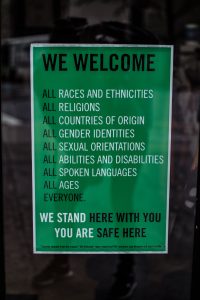Get started on a Diversity & Inclusion strategy with these 6 thought starters

Have you been wanting to build a Diversity & Inclusion (D&I) strategy but having trouble getting started?
This article shares 6 thought starters for you to discuss, use to get unstuck and build your own D&I strategy.
A formal strategy for making your workplace more inclusive and diverse will benefit employees and strengthen your business.
You can make your company a great place to work that also allows every employee to perform at their best.
Your starting place to build a Diversity & Inclusion strategy
Every company is different, but every company should build a Diversity & Inclusion (D&I) strategy.
For some, the strategy will continue great work that is already in progress. In others, the strategy will chart new territory and set the foundation.
If you have been tasked with creating, modifying or sustaining a D&I strategy for your company, these six thought starters can help you build a successful one.
This article does not provide a strategy. It offers a series of questions and considerations that you can use to guide the development of the strategy that is right for your company at this point in time.
The origin of these thought starters

In a recent corporate role, I held responsibility for D&I in addition to other Talent Management and Leadership Development areas.
Our company had not tackled D&I issues and strategy yet, so we faced the process of starting from the foundation and building up.
Over a few years, we created a strategy, defended it to the Board of Directors, developed and rolled out programs, created tracking systems for representation and program success and even made a public commitment to meet certain goals.
No easy solutions
Building the strategy and programs did not happen overnight. It required thought, time, effort, socialization across the organization and extensive communication.
We also did not immediately solve problems like lack of women in senior roles or benefit programs that caused problems for single parents. But we set some wheels turning and the momentum started to build. The company was moving down the right path.
These questions and thought starters are some of the things we wrestled with. Maybe they will help you move faster and accomplish your D&I goals.
Thought Starter 1: Identify why you are building a D&I strategy
Companies have many reasons for introducing D&I strategies. Identifying the end goals helps keep the strategy focused on the important elements.
These reasons guide your choices in building the strategy and also determine the messages you share.
Which of these does your company value the most?
Moral: supporting diversity and inclusion is the right thing to do. It is right and fair to give everyone the opportunity to succeed or fail based on their abilities and contributions versus inborn traits like race or gender.
Employee engagement: harnessing the diversity of thought of all employees will increase employee engagement. Employee engagement supports a strong workplace culture, higher productivity and retention.

Business: diversity and inclusion boosts bottom line performance of organizations. Many studies show the link between D&I and improved business results. (Check out this McKinsey & Company work for more details.)
Legal: companies must comply with government requirements and reporting.
Corporate social responsibility: consumers now expect companies to uphold certain standards in how they conduct business – such as using sustainable materials, not polluting and avoiding child labor. Embracing D&I also falls under the expectations of corporate social responsibility.
Valuing multiple reasons to build a Diversity & Inclusion strategy
Your company might focus on one primary reason or choose more. In my experience, we documented all of the goals as part of the D&I strategy to demonstrate that all of them were valued. In discussions, we would highlight different elements based on the audience.
For example, senior leaders preferred to hear about the business benefits; the board of directs showed interest in the corporate social responsibility and employees talked about moral and employee engagement goals.
Thought Starter 2: Get leader sponsorship
As you start your D&I strategy work, you must find senior leader support -preferably your CEO. Senior leaders create the culture through their words and actions. To create a diverse and inclusive culture, the senior leaders must talk about it, be willing to have difficult conversations, accept the messiness that can come with this work and follow through with commitments.
Some questions:
- Does your CEO support this work – both verbally and via actions?
- What leaders act as role models for inclusion already?
- Who are some of the influential leaders in the company who could speed up this process due to their visible support?
- How can you engage all leaders in this process and rollout?
Thought Starter 3: Scan your current state
Every company starts from a different place in terms of the state of their current strategy, programs in place and openness of leaders and employees.

Some questions to use to assess your current state:
- Is this your first D&I strategy or a continuation?
- Do you have any existing D&I related programs?
- Is your current state similar across the entire company? Do different groups, departments or locations have different situations?
- What are your current representation demographics (gender, ethnicity, disability, veteran status, etc.)? What are the demographic percentages across hierarchical levels?
- Do your employees reflect your customers?
- What issues concern your employees? What programs do they request frequently?
Thought Starter 4: Prioritize focus areas
Based on your identified reasons and current state, where should you start?
You can’t tackle everything at once, so you need to prioritize. In some cases, you will need to set a foundation first and then build on it. In other cases, you might already have a solid foundation and be ready to move faster to more advanced programs and messages.
Some common areas of focus for Diversity & Inclusion work include:
- Communication
- Training
- Talent Acquisition
- Community outreach
- Process/ benefit analysis
- Succession planning
Questions:
- Which one of these areas would create a good foundation?
- Which area would generate momentum and positive change?
- Have you communicated what D&I is and why it is important?
- Do of your employees have a shared understanding?
- Is D&I built into other Talent Management processes?
Thought Starter 5: Involve a broad spectrum of employees
D&I contains the word ‘inclusion’, so you should be inclusive about who works in this area. There are many ways to include a variety of people such as:

- Formal assignments: Some employees, usually in HR, should have a core job responsibility to work on D&I. Those employees set strategy, coordinate task forces and ensure that programs get launched.
- Developmental Assignments: D&I work provides a great developmental opportunity for high potential top talent. Assign high potential employees to lead projects, develop strategy or be liaisons with the community. This work exposes them to important issues and puts them into complicated situations. The challenge will stretch them and improve their overall leadership skills.
- Employee resource groups: Employee resource groups (ERGs) can help create strategy and implement programs. They often have deep knowledge in their area such as GLBT issues or black culture. Seek their input.
- Surveys: Use surveys to collect data on what current problems exist and what type of solutions employees would value. This approach touches many employees with minimum effort.
- Find the passionate champions: Every company has people at all levels throughout the organization who have strong passion regarding D&I. Find those people and ask them to participate on a task force. Pulling employees from different functions, departments, locations and levels provides diverse input, influence and champions during the roll out of programs.
Thought Starter 6: Communicate and execute consistently and persistently
D&I work in an organization extends beyond programs. It touches every part of the culture – how people are treated and feel every day. Good inclusion work requires commitment to sending the right messages and doing it consistently and persistently. Messages must come from the CEO and other senior leaders and match actions and programs.
- How can you build an ongoing communication plan for D&I messages?
- What internal communication channels can you leverage?
- How can you build D&I messaging into related programs like ones focused on leadership development or new hire orientation?
Once you launch programs and messages, you should also consider how you will track progress and make course corrections along the way.
Hopefully these thought starters will help you build a Diversity & Inclusion strategy for your company.



